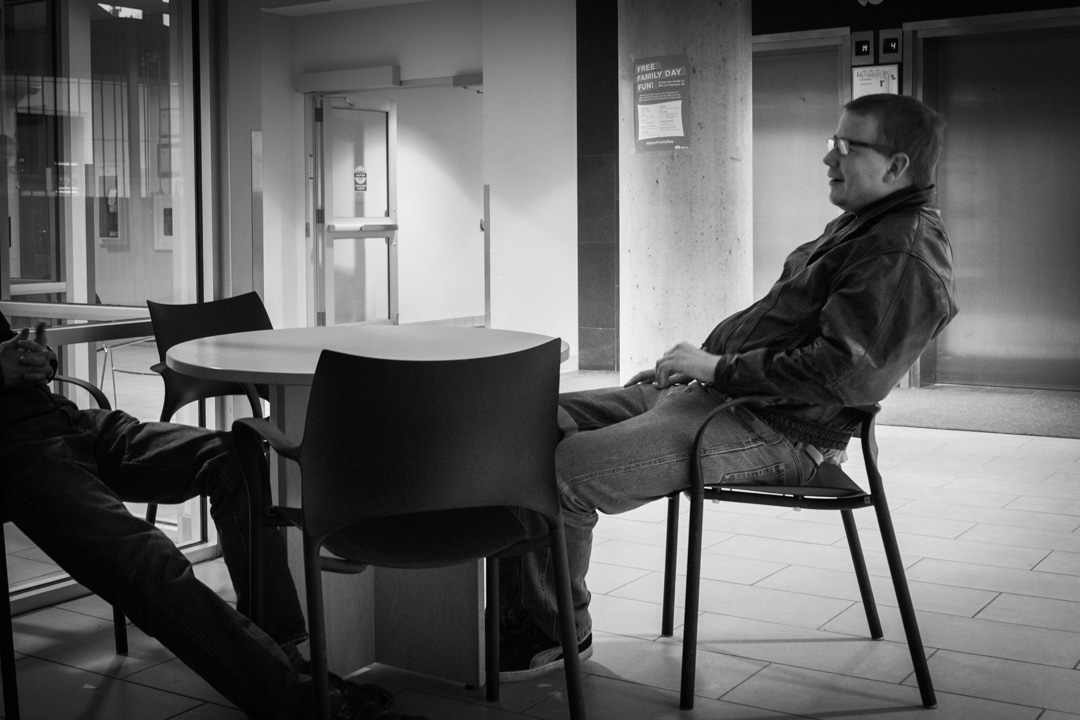Chapter 4:
AlecIt’s 4:30 pm on a Friday afternoon, and above zero degrees – a welcomed anomaly for a mid-February day in Edmonton. Most are taking advantage by eating on patios and strolling down Whyte Avenue – but not Alec Johnston.
A 28-year-old who’s had more career changes than most adults near retirement, Melcor program manager Alec Johnson seems to have found his calling.
I’m sitting in the lobby, watching a scene unfold that’s become a regular occurrence over my two-week stay. Alec – with papers in one hand and a phone in the other – talking down a tenant who’s had a disagreement with a neighbour. As he’s talking, a line of tenants waiting for a chance to talk to him begins to form in the lobby.
And as I watch him interact with person after person throughout the day, I know why he’s more than a staff member to them. He’s a friend.
He has an office, but I have the feeling it’s there more for appearance than practicality, since he’s always where people can find him.
A tall man with a soft face and bright eyes, he beams when talking about his work.
“This works just feels good,” he said. For him, it feels like they’re providing people with opportunities they might not otherwise get.
A large demographic of people in Edmonton are faced with significant barriers, and housing is difficult. Johnston said it’s nice being able to provide some needs and assist in tearing down some of those barriers.
As program director, his day-to-day schedule depends completely on the tenants’ needs. But he always makes sure they feel safe and feel like they belong.

Community Needs
Melcor thrives on understanding the many different needs of their tenants and providing supports and services to accommodate those needs. With a community revitalization occurring over the next decade, Johnston is worried it will drive out the inner-city community – people who need the housing the most.
It’s already happening. Rogers Place – the new arena spearheading the Ice District revitalization – officially opened seven months ago, and housing options in the area are closing. The YMCA of Northern Alberta – citing a single occupancy housing model that is out of touch with current best practices – will be closing its doors, affecting 120 people. The MacDonalds Lofts, a 102-year-old, low income, heritage building located behind Rogers Place, has been bought by the Katz Group (owners of Rogers Place) after being hit with multiple orders by the Alberta Health Services declaring inhabitable living situations. It’s unclear what Katz will do with the space and what will happen to the 91 residents living in the building. The city’s homeless and vulnerable population all reside in a concentrated downtown area, yet with revitalization increasing rent and cleaning up the streets, many hard-to-house individuals are left without a home.
Stigma
Fostering inclusion is a big part of the Melcor persona. The lobby is always filled with tenants; there are the regulars that come down to enjoy their morning coffee and read the paper. Some bring cookies to share. Others stay for hours talking and welcoming anyone coming through the doors.
Then there’s the play place, complete with a mini jungle gym, where kids play and moms relax.
You don’t get this sense of community in suburbia, said Johnston.
I can never sneak out the backdoor at the end of my day, he said. He said it’s a whole 20-minute process of just saying goodbye to everyone, and people who don’t have much invite their entire floor over for dinner. It’s incredible, he said.
All too often, there is an association made between crime and safety and affordable housing locations. Johnston said it’s a constant struggle once a certain building is labelled “affordable housing.” There’s an idea that people living in affordable housing facilities bring problems into the community; they’re derelicts, transient and drug users.
When Johnson first started working at Melcor, friends and family told him he was crazy to work in that neighbourhood; they told him to walk with keys between his knuckles.
There is a misconception that affordable housing programs cater to the “underbelly of Edmonton,” but Johnston argued that just isn’t true.
Its rough, he said, to always be fighting those uneducated views, but said those notions couldn’t be further from the truth.
“Don’t make judgements,” he said.
This community looks out for one another, people care for each other and the building. It’s their home and they are proud. If people saw this place the way he sees it, said Johnston, “there wouldn’t be that stigma of it being a scary place.”
“Because it’s not.”
As my time at Melcor ends, I find Johnston’s assessment of the Melcor tenants entirely accurate. I’ve been invited for dinner twice, asked to come see a tenant’s home four times, and had countless lobby conversations about everything from work to girlfriend troubles.
If I’m there early in the morning, I can’t walk through the front door without being stopped by various tenants, congregated outside for their morning smoke, eager to pass on the morning’s gossip.
People know their neighbours, said Johnston. He said they know you inside and out, the good and the bad.
“They take care of the building, and the people in it.”
